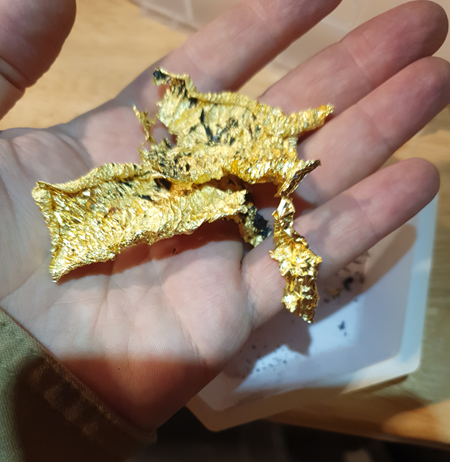 Parler
Parler Gab
Gab
- Researchers have confirmed Earth’s core is leaking gold and other precious metals toward the surface through volcanic activity, challenging long-held scientific assumptions.
- Ultra-high precision analysis of Hawaiian volcanic rocks revealed ruthenium isotopes originating from the core-mantle boundary, proving deep-Earth material is migrating upward.
- The discovery suggests volcanic hotspots act as pipelines, transporting trace amounts of gold, platinum, and palladium from the core to the crust over billions of years.
- This finding reshapes theories about Earth’s geological processes and raises questions about the origins of surface gold, previously thought to come from meteorites.
- While the core’s vast gold reserves remain inaccessible, the study highlights Earth’s dynamic interior and the ongoing mysteries of planetary evolution.
A golden breakthrough in volcanic rocks
The study, published in Nature, focused on lava samples from Hawaii, where volcanic activity brings material from deep within the Earth to the surface. Researchers analyzed traces of ruthenium (Ru), a rare precious metal, and found isotopic signatures matching those expected from the core. “When the first results came in, we realized that we had literally struck gold!” said Dr. Nils Messling of Göttingen University’s Department of Geochemistry. “Our data confirmed that material from the core, including gold and other precious metals, is leaking into the Earth’s mantle above.” The key to this discovery lies in ruthenium’s isotopic composition. Compared to the mantle, Earth’s core contains a slightly higher abundance of the isotope 100Ru, a fingerprint left over from the planet’s formation 4.5 billion years ago. Until now, these differences were too minuscule to detect. But advanced new techniques allowed scientists to identify these telltale traces in Hawaiian lava, proving their origin at the core-mantle boundary.Core-mantle interaction: A planetary game-changer
For decades, scientists believed Earth’s core was entirely isolated, its metallic riches forever beyond reach. This study shatters that assumption. “Our findings not only show that the Earth’s core is not as isolated as previously assumed,” said Professor Matthias Willbold, a co-author of the study. “We can now also prove that huge volumes of super-heated mantle material—several hundreds of quadrillion metric tonnes of rock—originate at the core-mantle boundary and rise to the Earth’s surface to form ocean islands like Hawaii.” This process suggests that volcanic hotspots, such as those beneath Hawaii, act as geological pipelines, funneling trace amounts of core material—including gold, platinum, and palladium—toward the crust. While the leakage is minimal compared to the core’s vast reserves, it hints at a dynamic planetary interior that is far more active than once believed.Where does Earth’s surface gold come from?
The discovery also sheds light on a long-standing mystery: Why is there any gold near Earth’s surface at all? Conventional theories suggest that most of Earth’s accessible gold arrived via meteorite impacts after the planet formed. But this new research implies that some may have risen from below. “Whether these processes that we observe today have also been operating in the past remains to be proven,” Messling cautioned. Still, the findings open a “new perspective on the evolution of the inner dynamics of our home planet.” For those dreaming of mining Earth’s core for its gold, however, reality remains harsh. The core begins nearly 1,800 miles underground, which is far deeper than any drill could reach. Even if precious metals are slowly migrating upward, extracting them would require unimaginable technological advances. Beyond its scientific significance, this discovery underscores a critical truth: Earth’s deepest secrets are still being uncovered. The findings also highlight the fragility of humanity’s reliance on finite resources. With gold and platinum-group metals essential for electronics, renewable energy, and medical devices, understanding their origins—and potential future supplies—is vital. Sources for this article include: DailyMail.co.uk FoxNews.com The-Independent.comNew research suggests Milky Way may avoid catastrophic collision with Andromeda galaxy
By Cassie B. // Share
Exercise as a promising natural treatment for depression
By Evangelyn Rodriguez // Share
By Finn Heartley // Share
Silent invasion: Oral inflammation’s role in systemic disease, from gum disease to heart health
By Willow Tohi // Share
Governments continue to obscure COVID-19 vaccine data amid rising concerns over excess deaths
By patricklewis // Share
Tech giant Microsoft backs EXTINCTION with its support of carbon capture programs
By ramontomeydw // Share
Germany to resume arms exports to Israel despite repeated ceasefire violations
By isabelle // Share










